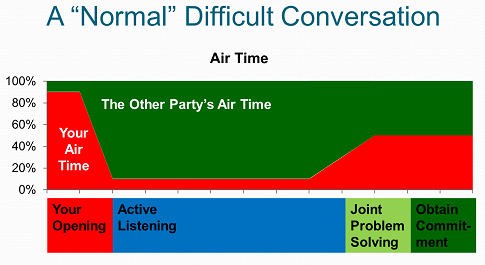When you walk in the room, who shows up for Read more →
Two Steps to Active Listening
Posted Tuesday, April 29, 2014Listening skills are critical for leaders. Listening opens the channels for two way communication. And it is not enough to simply be present when others are talking. You must engage in active listening, the art of listening with intensity to truly hear what the other person says, knows and feels.
I have coached b-school students, change management clients and leadership coaching clients on how to listen better. Based on those experiences, here are two steps for active listening.
1. Be Quiet
The first step to active listening is simple. Stop talking. Let the other person speak without interruption or comment from you. Surprisingly, this step is often the hardest, especially for people who are smart, driven and successful.
Sometimes we act as if silence implies consent. When someone says something wrong or they focus on unimportant aspects of the issue, we want to jump in to set things right. But you can hear without necessarily agreeing. Like a reporter interviewing politicians or a researcher gathering consumer opinions, you might not agree with what is being said, but you can stifle your impulse to speak in order to truly understand the other person’s point of view.
There is another reason to be quiet. Silence is power. In most social situations, we expect talking to fill every moment. Your silence implies personal control. Being silent means you are confident and comfortable. If you can be quiet, the other person may feel compelled to fill the uncomfortable silence.
2. Focus on the Other Party
The point of active listening is to get the other person’s perspective. To do that, you must focus on them – completely.
Use reflective listening. Repeat and paraphrase what you hear. Use phrases like “I hear you saying…” or “It sounds like…” Ask questions of clarification like “Why do you think that happened?” “When did she first say something?” or “How did that work out?” Summarize their key points. When they have given you lots of facts and reasons, try to draw out the themes. And be tentative, always checking with them to see if you understand what they are trying to say.
But it is not enough to listen to the other person’s words. You must also watch their non-verbal communication. Watch facial expressions, tone of voice and body language. Check your observations by using the phrase “You seem to feel . . .” It is especially important to notice when their words and their non-verbal communication seem to be at odds. For example, if the other person tells you they fully support a certain decision (while their eyes are downcast, their voice has no energy and their posture is slumped), follow up to see if there are some unspoken concerns.
A Difficult Conversation
Suppose you need to have a difficult conversation with someone. You may need to discuss a broken commitment, call out unacceptable behavior or give feedback on poor performance. While you might think talking more increases your chance of persuading them, you might be surprised by the power of active listening. The best difficult conversations follow this pattern:
 Active listening is central to this difficult conversation. By being quiet and focusing on the other party, you are helping move them toward joint problem solving and commitment. Your active listening helps them process the difficult topic. You are gaining credibility by listening. And, you will actually learn their perspective, which may change your mind about the situation and the other person.
Active listening is central to this difficult conversation. By being quiet and focusing on the other party, you are helping move them toward joint problem solving and commitment. Your active listening helps them process the difficult topic. You are gaining credibility by listening. And, you will actually learn their perspective, which may change your mind about the situation and the other person.
Difficult conversations require wisdom. Active listening is a great way to be wise. “Whoever restrains his words has knowledge, and he who has a cool spirit is a man of understanding.”¹
If you are like me, you sometimes struggle with difficult conversations. Active listening is a great way to fake wisdom. “Even a fool who keeps silent is considered wise; when he closes his lips, he is deemed intelligent.”²
A Gift
Many people live in a cone of silence. They go through most days without being heard, without being really listened to. As a leader, you can give a few minutes of your time by actively listening to the people you lead. The benefits to them and to your organization will be worth your time.
__________________________
¹Proverbs 17:27
²Proverbs 17:28


Pingback: You're Not Listening
Pingback: Images of Listening